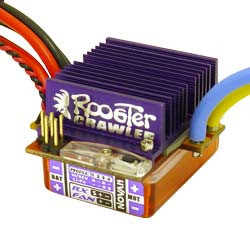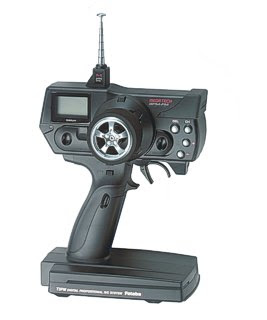
The Clodzilla is now a runner. Initial impressions are of a whole load of torque, although on the downside there is an equal whole load of flex in the steering assemblies. I know that ESP offer metal steering transfer joints to replace the stock plastic items, but these will not fix the not inconsiderable movement in their right angled servo mounts. I've mounted the fore and aft rods two holes higher on the servo bellcranks than the static range suggested, and this compensates for the flex to a degree, but this isn't the ultimate solution. The servo mounts pick up on the two standard motor mounts, unfortunately they would have been better if these items had been longer and had three mounting holes, possibly utilising the screw location on the very back ends of the gearboxes. I didn't cut off the standard servo mountings on the servos themselves so I may be able to make an additional brace using these.
As far as the radio set-up goes everything went fine. I've still got a bit of tinkering to do, particularly on the braking side because the truck stops a little too dead as soon as I take my finger off the trigger. I didn't need to reverse one of the channels as suggested below, and whereas someone on the forum (linked to below) had trouble getting his rear servo to work in both directions this was overcome by setting the CH3 value to zero where it had previously been set to 100, although I don't know what the default value was because I have a second-hand transmitter and I didn't reset it to the factory settings, instead I simply adjusted the values to those required.
There are still a few things to do, like touching up a couple of scratches and mounting the off/on switch. I've also got to remake the battery joining leads as I think I need a thicker cable at the paired end, I didn't have any 14 or ideally 12 AWG cable when I was making them, and anyway it was a trial run to get the lengths right. I've spurred off an extra pair of leads from the point where they join together to create a remote charging point because all the other joints are a bit inaccessable.
The truck now weighs in at just under 10lbs, discounting the shell. I will at some point (I've been meaning to do this for a while now) make a pair of gearbox skid plates which will extend to protect the lateral steering rods.
As soon as the sun shines again I'll be off to find some rocks...




































